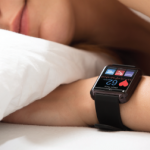The company has already partnered with Medidata for use in clinical trials.
The module part of HealthPatch MD is reusable, but the patch that sticks to the skin contains the battery, which lasts just two or three days, depending on whether data are constantly being streamed to a mobile device. So the patch needs to be changed regularly.
That involves sliding the reusable module—a thin, wafer-like object similar to the SD card of a digital camera—out of the center of the patch and then removing the backing, exposing the adhesive, and reattaching the HealthPatch to the skin.
The ubiquity of mobile devices & networks, … & consumers’ growing savviness about mobile technology are pushing the adoption of these technological innovations.
“It’s a fairly simple process,” Selvik says.
The device is okay for use in the shower, but there are different grades of adhesive geared toward different levels of activity and different levels of perspiration. The device comes with “gentle,” “active” and “high performance” adhesive options. The advantage of the gentle is that the patch can be taken on and off more freely; once one of the stronger adhesives is used, it can typically not be reattached, and another patch would be needed, Selvik says.
He acknowledges that the need to change the patch with the battery so frequently makes the device less desirable for use as a general wellness tool. But that is not the target user, he says.
Designed for Medical-Grade Data
“This device makes sense for people on the extremes of health,” he says. “Either you’re sick and you have a known issue, or you’re a super athlete and you want medical-grade information about what you’re doing.
“This device is a medical device, and we are focused squarely on medical applications vs. the wellness and the fitness [users].”
Selvik says the device could also have an impact in the inpatient setting, where patients could be monitored much more closely than they are now—only when a nurse does rounds.
“That happens maybe once or twice a shift,” he says. “The thing is, people can decline very, very rapidly, and you’d really like to know within minutes if you’re seeing a significant change in someone’s vital signs rather than hours. And that will save lives.”
Study Needed
Enthusiasm was limited for at least two rheumatologists who have studied the links between rheumatologic diseases and cardiovascular events.
“This is similar to another device on the market called BodyGuardian,” says Eric Matteson, MD, chair of rheumatology at Mayo Clinic. “Neither of these has been demonstrated to be of value as a home health accessory. I think at the moment we cannot say that it would have value at this time in the context of preventative cardiology. I would not recommend it until it is better studied in the context of preventive cardiology.”

